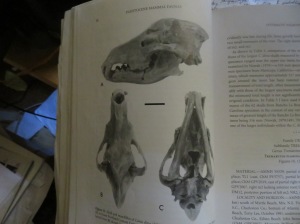I was confused about the Harleyville Giant Cement Quarry fossil site for many years. Some of the scientific literature reported the fossils found there were over 300,000 years old, while other papers gave them an approximate age of 20,000 years BP. Finally, someone sent me a message, clearing up my confusion. These are 2 different fossil sites–both in Dorchester County, South Carolina but several miles apart. In 1989 Roy Ogilvie, an amateur fossil collector, found a nearly complete dire wolf skull at the site with the 20,000 year old bones. This specimen is now stored at the U.S. National Museum and was given the number 437648. It is the only dire wolf (Canis dirus) skull ever found in South Carolina, though several isolated teeth have been recovered from other sites.
Photo of specimen #USNM 437648 from the below referenced book. It’s nearly complete, missing just a few teeth.
The size of this skull is remarkable. Ronald Nowak, a renowned fossil canid expert, measured 62 dire wolf skulls that were excavated from the La brea Tar Pits in California. #USNM 437648 is larger than all of them. It may just be coincidence, but perhaps eastern dire wolves were on average larger than their western counterparts. In any case this was a big wolf. However, it is not the largest dire wolf skull known. A dire wolf skull from south Texas and another from the Maricopa tar seeps in California were slightly larger than this specimen.
The associated faunal remains, known as the Ardis local fauna, suggest #USNM 437648 lived in a mostly wooded habitat with some grassy openings and aquatic habitats. Tapir, white-tailed deer, stout-legged llama, long-nosed peccary, woodrat, beaver, gray squirrel, flying squirrel, jaguar, Florida spectacled bear, and Jefferson’s ground sloth all are (or were) denizens of woodlands or even deep forest. Mastodon, beaver, and river otter indicate wetland habitat. Bison, horse, mammoth, meadow vole, hog-nosed skunk, 13-lined ground squirrel, and pampathere show that grassland environments existed here as well. Dire wolves were a generalist species. Specimen #437648 likely hunted in all 3 habitats.
Reference:
Sanders, Albert
Additions to the Pleistocene Mammal Faunas of South Carolina, North Carolina, and Georgia
American Philosophical Society 2002
Tags: dire wolf, largest dire wolf skulls ever found, Specimen437648

Leave a comment